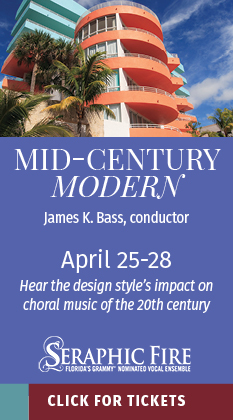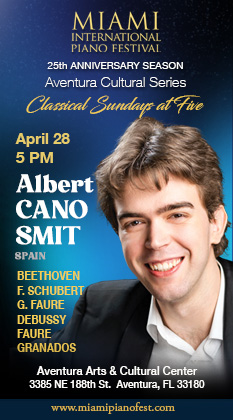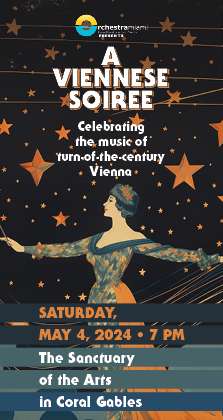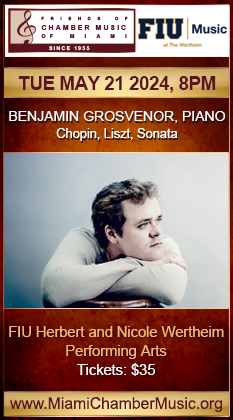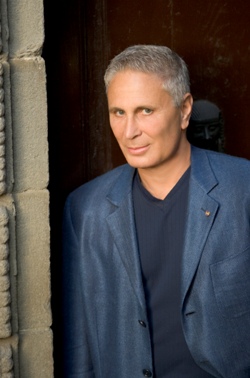
Festival Miami ushers in a new era this Thursday when the Frost School of Music’s concert series opens its 25th season with a celebration of John Corigliano’s music at the Adrienne Arsht Center for the Performing Arts.
Violinist Jennifer Koh will be the soloist in Corigliano’s Red Violin Concerto, and the American composer’s L’invitation au voyage will also be heard. But most significant is the Florida premiere of Corigliano’s Circus Maximus for wind ensemble. This is the first time the University of Miami’s fall festival has moved off campus, part of a revamped structure overseen by Frost School dean Shelly Berg. Berg has grouped the festival into four thematic weeks by musical genre, with Thursday’s event kicking off the classical music lineup and succeeding weeks devoted to jazz, pop and Latin music through Nov. 3. There has been some grumbling from inside and outside UM about the festival retooling. But it’s hard to fault the classical programming, particularly the opening-night tribute to Corigliano, who, at a remarkably youthful 70, stands as one of our finest and most original composers. His Symphony No. 1, a powerful and deeply felt homage to friends the composer lost to AIDS. remains the great symphony of the modern era. The Symphony No. 2 for strings, a retooling of his String Quartet, is less outwardly flashy, but an equally rich and probing work. Circus Maximus, Corigliano’s third symphony, is reflective of the composer’s style with its audacious scoring, pointed social commentary and extreme and unorthodox challenges for musicians as well as conductor. Still, it’s a singular work in Corigliano’s canon, originating with his desire of “revitalizing the concert hall.”
“In Beethoven’s day the only way you could hear his music was in a concert hall,” says Corigliano from the home he shares in upstate New York with long-time partner, composer Mark Adamo. “Now you can jog while you’re listening and look at the sunset. It’s a very different world.
“So I wanted to take that particular space and think what could happen here with 2,800 people that can’t happen in your living room? And the answer, is I can be spatial for the whole piece.”
Utilizing the concert venue in an offbeat way is not entirely new to Corigliano’s art. His Clarinet Concerto arranges instrumentalists about the hall and the Pied Piper Fantasy is scored for children to play toy instruments in the audience and for the flute soloist to make a theatrical entrance and exit. Circus Maximus takes this to another level with a 75-member wind ensemble, including 11 trumpets spread out through all levels of the Knight Concert Hall, with the distancing and varied sonic perspectives a key element of the performance. The work also calls for marching band and is capped by some of the most deafening passages one is ever likely to encounter in a classical venue, including a two-minute sustained chord that makes Shostakovich’s climaxes seem like a Haydn string trio.
Apart from the spatial element, the other inspiration came from Corigliano’s love of ancient Roman history, particularly the vast entertainment hippodromes like the Roman Coliseum and the Circus Maximus. He sees firm parallels between the gladiator battles and Christian sacrifices of Rome and the electronic bread and circuses served up by our own plasma TVs, iTune downloads, and unsavory popular culture like The Jerry Springer Show.
“I walked through it and around it,” he said of the ancient Circus Maximus site. “Now it’s just a field. It’s enormous. But for a thousand years it was daily entertainment for Rome for 400,000 people a day. The government wanted to keep the people amused between the Coliseum and Circus Maximus And they didn’t realize things were crumbling until they finally fell. We don’t have arenas of 400.000. But we do have television, and the internet and the blogosphere and all these things are ways of getting our entertainment.
“We are besieged by entertainment. We’re just saturated with information, if you look at a news broadcast you’ve got the crawl on the bottom, you have the newscaster talking and in the right-hand corner you have a picture of something else. So many different activities have to happen at the same time today. And there’s a shorter attention span because we’re multitasking like crazy. We’re able to do five different things without doing anything neatly. “
Corigliano says he’s just as guilty as anyone else but sees personal and political dangers in the fact that the plugged-in accoutrements that make contemporary life rewarding also make it more tense and unsettled. “I can’t say I don’t like my iPhone because I love it,” says the composer. “I don’t want to give it up. I love the technology: my plasma flat screen TV and my computer.
“But the same technology that brought us our iPhone is also the technology that can bring about our destruction. With one bomb our world will be over. If New York City goes up, everything’s over, kiddo. So Circus Maximus is a piece that celebrates all of this wildness and craziness and yet is terrified of it.”
That influence is clearly felt in the third movement, appropriately called Channel Surfing. Different groups of instruments are spread throughout the hall each with their own music to play. With a remote-control click, we switch from dance music to pathos to cartoons in an instant. “Nothing lasts more than a minute because you get bored,” says Corigliano. “The interruptions become faster and faster.”
Most challenging for the players is the Circus Maximus movement, which concludes with a massive single chord, a “super-saturation” that, Corigliano says, is likely “the loudest noise ever heard at Carnegie Hall.” A “Prayer” follows that tries to make sense of all the cacophony, but the music again grows louder, wilder and more frenzied. Finally, the work ends with a violent shock, a shotgun blast that symbolizes for Corigliano what the stakes are of the current world situation. “That’s the only way I could think of ending a piece like that,” he says.
The man in charge of conducting this daunting work is the Frost School of Music’s Gary Green, leader of the Frost Wind Ensemble. Green heard the Carnegie Hall premiere but confesses he was not initially that taken with the music. “I was moved by what John is trying to say in this symphony. I was deeply affected but not musically.”
Indeed his first reaction was that it was “very loud.” Initially I thought it was sensory overload,” says Green. “There was so much, I couldn’t tell where the craft was.” A second hearing in Washington with Leonard Slatkin leading the U.S. Marine Band, and further study of the score led Green to find its musical depth and political significance. “I tried to approach it with the composer’s view and I’m really finding the craft in the piece now,” says Green. “It’s been a learning experience for me and teaching this piece to students has been exhilarating.”
Green’s favorite sections are the more interior sections of this wildly theatrical work: the penultimate Prayer movement, which he believes offers “five minutes of John’s most beautiful music.” and the nocturnal, evocative Night Music I. “In not one place is there a time signature,” says Green of that movement. “It’s all based on feel and flow of sounds, There are wolf sounds here, nature sounds. It’s so quiet and unearthly, it’s surreal.” That startling coda with the shotgun blast is problematic since even in these days of diverse course offerings, few music schools offer double majors in instrumental performance and marksmanship. Fortunately, for Green, he had an enthusiastic volunteer in Liana Purcell, the Wind Ensemble’s pianist, who will be firing the full-load blast at the coda.
The 25-year-old musician grew up in Georgia, when the nation was breaking away from the Soviet Union amid much violent civil strife. “We had a sniper on our roof for a while,” she says. “I grew up in a war and guns were a very common thing. I like shooting. It calms me down.”
Purcell also recognizes that the shotgun blast is not just to provide a theatrical effect but to conclude the symphony on a powerful and pessimistic note. “The shotgun is a sign like it’s the end of the world. It’s telling people to wake up, and saying you missed a chance to make things better.”
Corigliano confesses that it was a relief to be finished with all the celebrations, performances and occasions of his 70th birthday season last year. “I’m not pressured terribly like last year, when it was like chaos. I had two days at home and five days away every week. When you realize you’re 70, you do feel old. Not in terms of moving around but psychologically it does sound differently than 69.”
He continues to be one of the most performed and recorded of living composers, with his Bob Dylan tribute Mr. Tambourine Man, just released on Naxos and a CD of Circus Maximus will be out on the same label in December.
He’s also one of the few living composers to have a performing string quartet named after him. “I’m touched and amazed that they asked me,” he says. “I’m very honored.”
Corigliano hasn’t yet begun work on his fourth symphony but he already knows exactly what form it will take and has set himself a challenge: a work written entirely for large chorus singing sounds but no words.“It will be more than vocalise,” he explains. ”The voice can do more than just sing. So if you can orchestrate what the human voice and body can do and you have a hundred people it can be a very interesting piece. But I have a lot to learn about the chorus before I can write that.”
Festival Miami opens with John Corigliano’s Circus Maximus, L’Invitation au voyage and the Red Violin Concerto with soloist Jennifer Koh, the Frost Wind Ensemble, the Frost Symphony Orchestra and Frost Chorale. 8 p.m. Thursday at the Adrienne Arsht Center for the Performing Arts, Miami. Tickets are $15-$75. www.festivalmiami.com; 305-284-4940.
Posted in Articles
Leave a Comment
 Festival Miami ushers in a new era this Thursday when the Frost School of Music’s concert series opens its 25th season with a celebration of John Corigliano’s music at the Adrienne Arsht Center for the Performing Arts.
Festival Miami ushers in a new era this Thursday when the Frost School of Music’s concert series opens its 25th season with a celebration of John Corigliano’s music at the Adrienne Arsht Center for the Performing Arts.